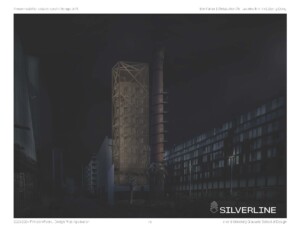SILVERLINE: A New Model for Data Centers in the Age of AI: Verticalities at the Edge of the Cloud

by Ben Parker (MAUD ’24), Christopher Oh (MAUD ’24), Ziyang Dong (MArch ’25), Jasmine Ibrahim (MRE ’25) — Recipients of the Plimpton-Poorvu Design Prize, First Prize.
Data centers underlie all the most important technological developments of the past three decades, and emerging innovations like generative AI rely even more heavily on the remote storage and computing that data centers provide. Yet for all their transformative impact, data centers are remarkably conventional buildings. The typical model of data center development holds the same pitfalls and consequences of most construction: degraded water quality, habitat destruction, car dependence, failing power grids, unchecked sprawl, visual monotony, increasing wealth disparity, and accelerated climate change. This need not be the case.
Silverline: Positive Potential at the Edge of the Cloud
As a design-driven real estate startup, we bring to data center buildings all the transformative aspiration that technologists bring to the servers within it. We propose a new model of data center development that preserves land, minimizes fossil fuel emissions, respects cultural context, and invests in disadvantaged communities, all within an attractively profitable financial model made possible through a new product type.
Silverline Edge-Colo data centers are medium-sized, 8-28 megawatt data centers that support low latency applications. They utilize a series of technological innovations to bring increased energy efficiency and better price-to-performance compared to traditional data centers. Immersion cooling and robotic operations reduce MEP costs through minimizing building HVAC and lighting requirements, resulting in competitive construction costs and hyper efficient power use (PUE). A system of nested modularity creates economies of scale and connects into an integrated system that starts with the microchip. This uninterrupted modularity, from chip to server to rack to building, creates the possibility of streamlined procurement, cutting construction time to further save on cost. Finally, biomethane fuel cells replace diesel fuel as the power source for the data center’s backup generators, a significant sustainability improvement.
Silverline’s Thin, Vertical Typology Addresses Land Constraint Issues
The data center industry has made great strides in power use efficiency and renewable fuels but has yet to consider land as a sustainability issue. In contrast to the traditional, land-hungry approach, Silverline proposes a vertical model: each data center tower holds 4-24 levels of server racks with mechanical equipment above and below. In urban areas where land is expensive and parcels can be small or unusually shaped, this provides more flexibility to locate near customers. In rural areas, where agricultural and ecological land preservation is a core issue, a tower solution disturbs less land and can minimize regulatory hurdles regarding zoning changes.
Colo-Edge Data Centers: Digital Proximity is the New Industry Buzzword
The proliferation of low latent technologies involving AI has become a strong tailwind for building urban data centers. The benefits of locating close to the end consumers of data outweigh the construction premium, which is absorbed via higher rents charged to tenants. Investment grade cloud providers like Google and Amazon are willing to pay a premium to be closer to the end consumer and ensure high customer retention.
Blue Ocean Strategy: First Mover Advantage in a High Growth Market
Digital consumers and businesses are pushing data closer to end users, where industry research has noted higher growth rates compared to the established “hyperscale” in the mid-to-long term. Despite this demand for expanding edge infrastructure, cloud providers are deterred by the high barriers to entry in securing downtown land and seeking permitting approval for data center development from the local authorities in both urban and rural locations.
Bridging the Digital Divide with Decentralized Colo-Edge Data Centers
Access disparity between urban and rural internet users remains an important issue for digital infrastructure. As an incentive for local governments to lease land in dense urban cores for data center developments, Silverline will cross-subsidize data centers for underserved rural populations, allowing these communities to access high speed internet. Rural data centers also support 5G connection, an infrastructure upgrade that would increase demand density in rural areas to achieve competitive market rents in the near future.
Modular Core, Adaptive Shell: Contextualizing an Anonymous Box
Local public opposition has halted recent data center projects in Ireland, the US and other countries, with moratoriums on some data center construction in Singapore and the Netherlands. Such community concerns have the industry rethinking its traditional approach to data centers as large, anonymous, unidentifiable boxes. With each data tower, Silverline pairs a modular core with a contextually adaptive shell that incorporates aesthetic and ecological considerations. The core is identical in every project, while the shell is the product of local architectural competitions sponsored by Silverline. The core holds all of the technological components of the building, while the shell addresses outward considerations of structure, façade, circulation, and how the building meets the ground. This opens a dialog between infrastructure and design that could manage the tension between ubiquitous use of the cloud and a similarly ubiquitous opposition to its physical presence.
To test Silverline’s globally adaptable core + shell strategy, we will first develop Silverline in paired urban/rural locations in Ireland, a strong market with mature planning practices and significant sustainable power. We then envision a scenario in Malaysia, a leading growth market with starkly different environmental, cultural, and regulatory conditions. Silverline would then continue expanding globally as the product is tested and refined.










